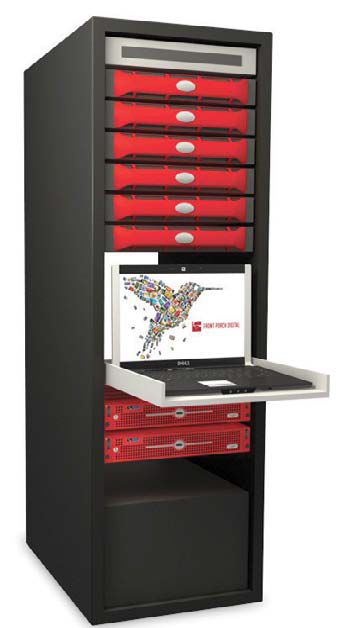Modified ‘Hybrid Storage’ Offers Many Options

CTV BellMedia’s Harris server Installation in Toronto
OTTAWA, ONTARIO, CANADA—In the IT world, “hybrid storage” refers to a mix of data storage on local servers/networks, and in the cloud; i.e. on remote servers whose capacity and access is managed by third-party cloud provisioning companies.
Mindful that TV broadcasters have an ongoing need for large-scale video storage, broadcast equipment manufacturers such as Avid, EVS, Front Porch Digital, and Harris Broadcast have all embraced the hybrid storage concept, and modified it to serve specific client needs.
A SHARED, NATIONAL FILE-BASED PRODUCTION SYSTEM
CTV BellMedia is Canada’s largest commercial broadcaster, and a user of Harris Broadcast’s Nexio video server/storage platform. “We have about 13 Harris production systems installed across the country, ingesting HD video from Sony XDCAMs and Sony PMW-EX35 camcorders,” said Martin Persaud, CTV BellMedia’s manager of engineering projects.”
In the past, each of these production centers were essentially isolated islands, resulting in multiple locations all storing the same content—like an NHL game—for sports highlights. To eliminate this waste, and to allow all CTV BellMedia newsrooms to have fast access to all of its news video, CTV BellMedia connected all of these sites into a single video production network, and added Nexio Farad online storage to make all video available to all of its editing stations.
In this twist on hybrid storage, “it no longer matters where the video is stored,” Persaud said. “Some of it is likely stored on the Farad unit within the station that an editor is working within, while some more is located in other cities. What matters is that our editors and producers in all CTV Bell- Media newsrooms have access to all of our news content.”
The largest Nexio Farad site is based in CTV Bell- Media’s network production headquarters in Agincourt in Toronto, and holds 2,000 hours of HD footage in the XDCAM50 and EX35 formats. Other Nexio Farad storage servers in other locations can store anywhere from 450 to 1,000 hours of video in this same format.
The professional video industry's #1 source for news, trends and product and tech information. Sign up below.

Front Porch Digital DIVArchive “Today, about 60 percent of the footage shown on our newscasts is sourced from our Nexio Farad gateway,” said Persaud. “Where necessary, the system automatically and invisibly transcodes incompatible video into the right format for the station requesting the file transfer. We also no longer have three user groups recording the same hockey game: One does it, and then all three pull what they need from the same single video file.”
EDITING LOCALLY, USING THE CLOUD
The advent of local/cloud hybrid storage has opened up some interesting possibilities for editing. Rather than having a satellite newsgathering vehicle send video directly to a single station, a modern SNG unit can transmit this video into a private (secure) cloud-based storage solution. Once the video is there, it can be accessed by editors and producers worldwide, as long as they have password-protected access to it via the Web
This is the concept behind Avid’s Interplay Sphere. “With Interplay Sphere, an Media Composer/NewsCutter editor working everywhere—even in a coffee shop with Wi-Fi—can go into the station’s private cloud, and edit video; either directly or by using low-res proxy files,” said Dana Ruzi ka, Avid’s vice president of segment and product marketing. “They can then put the finished video into the cloud, for access by everyone else on the news LAN. This takes the concept of hybrid storage to a dynamic new level, one that supports interactive ingest and production everywhere.”
EVS’ C-Cast also leverages the cloud to enhance mobile production. “With C-Cast, a mobile truck can send footage directly via the Internet into a broadcaster’s private cloud, where it can be accessed by everyone in the station’s network,” said Johann Schreurs, EVS’ market manager of interactivity and remote connectivity. “The video can be sent to other data centers, or indeed wherever the broadcaster needs it to go. It is far more efficient, in terms of video production, than a conventional mobile-studio link.”
Sporting Innovations of Kansas City, Mo., uses C-Cast to create live in-stadium multimedia content at Sporting Park, home of Sporting Kansas City, the market’s Major League Soccer team. “With C-Cast, we can take multiple camera angles, upload them to the cloud, and then let fans in the stadium download them using our Uphoria mobile experience,” said Brian Smith, Sporting Innovations’ senior video and stadium vision engineer.
TRULY HYBRID

Sporting Innovations of Kansas City, Mo., uses EVS C-Cast to create live in-stadium multimedia content at Sporting Park, home of Sporting Kansas City, the market’s Major League Soccer team. Unlike other equipment manufacturers who have adapted the idea of hybrid storage, Front Porch Digital, a Denver-based provider of digital content management solutions, has adopted the concept in its original form.
Hybrid storage is the basis of the company’s Lynx cloud-based content storage management service. It allows broadcasters who use Front Porch Digital’s DIVArchive media asset management software locally to send their files in and out of the FPD Lynx cloud, at a rate that can work out to less than $0.01 per Gigabyte stored.
“Because the video and data files are stored at data centers with geographically disperse locations, a broadcaster’s most precious asset—their content—is protected against natural and manmade disasters,” said Andy Hurt, Front Porch’s vice president of product management and marketing. Lynx can be used to store all kinds of files—not just video—and FPD promises 99.9 percent system uptime and accessibility, 24/7.
James Careless is an award-winning journalist who has written for TV Technology since the 1990s. He has covered HDTV from the days of the six competing HDTV formats that led to the 1993 Grand Alliance, and onwards through ATSC 3.0 and OTT. He also writes for Radio World, along with other publications in aerospace, defense, public safety, streaming media, plus the amusement park industry for something different.

